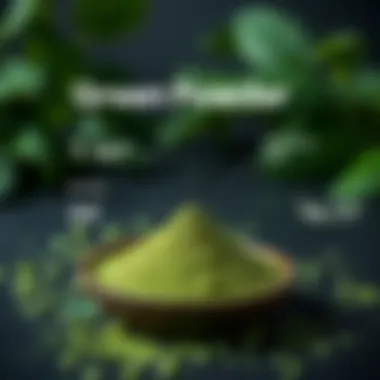Understanding the Components of Green Powder Supplements


Intro
Green powder has emerged as a staple in the world of nutritional supplements, capturing the attention of health enthusiasts and casual consumers alike. This vibrant blend of various superfoods promises a multitude of health benefits, from boosting energy levels to improving digestive health. However, it often leaves a person scratching their head: what exactly is in this green powder, and why has it become so popular?
As we dive into the composition of these enigmatic mixtures, it’s crucial to unpack the typical ingredients that grace the labels of green powders. These ingredients not only contribute to the rich color but also pack a punch when it comes to nutrients. Whether you’re a seasoned health buff or just stepping into the realm of supplemental greens, understanding what goes into your green powder of choice could be the key to maximizing its benefits.
The journey through the world of green powders will reveal not only the common superfoods found within but also their individual contributions to our health. Armed with this knowledge, one can walk into a store with confidence, knowing exactly what to look for when selecting a product. This exploration aims to provide clarity and insight into how green powder can be a valuable addition to modern diets, forgiving its sometimes muddled reputation.
So, let’s roll up our sleeves and dig into the nitty-gritty of green powder’s composition.
Defining Green Powder
The term green powder has made its way into the nutrition dialogue, particularly in recent years, as health-conscious individuals seek innovative ways to boost their diets. At its core, green powder refers to a blend of powdered ingredients derived from various plants, primarily focusing on nutrient-dense leafy greens, superfoods, and algae. This article strives to delineate what exactly constitutes green powder while also delving into the rising trend that has placed such products in the limelight.
What Constitutes Green Powder?
Green powders typically contain a medley of components that are often lauded for their health benefits. While formulations vary widely among brands, there are common categories that frequently appear:
- Leafy greens: Spinach, kale, chard—these staples are rich in vitamins A, C, and K while being low in calories.
- Algae: Spirulina and chlorella deserve attention for their high protein content and assorted micronutrients like iron and calcium.
- Grasses: Wheatgrass and barley grass, packed with chlorophyll, are sought for their detoxifying abilities.
- Superfoods: Ingredients like moringa, matcha, and beetroot powder often make an appearance, each with its unique set of antioxidants and beneficial properties.
Together, these elements work synergistically to create a potent, concentrated source of nutrition. It's essential for consumers to understand the specific ingredients included in their chosen product and how these can impact overall health.
The Popularity Surge
Over the past decade, the popularity of green powders has skyrocketed, turning them into a darling of health enthusiasts and busy individuals alike. Why? The allure of ready-to-use nutrition cannot be overlooked. In a fast-paced world where time is often at a premium, green powders present an appealing solution to get a burst of nutrients without the fuss of meal prep.
Rising awareness of plant-based diets and the role that superfoods play in health is fueling this trend. Social media platforms abound with testimonials and vibrant photos showcasing smoothies and bowls that prominently feature green powders. This visibility contributes to a growing consumer base that values both convenience and quality.
"Green powders not only provide a nutritional boost but they also suit current lifestyle choices geared towards wellness and health optimization."
It’s worth noting that while the surge in popularity has made green powders more accessible, it has also led to a crowded market filled with diverse options. Therefore, understanding what makes a quality green powder is vital as consumers navigate this expanding landscape.
Primary Ingredients
Understanding the makeup of green powder is essential for anyone dabbling in nutritional supplements. The primary ingredients are the backbone supporting the assertions made regarding health benefits and overall efficacy. These components are not just a random collection of greens, but specifically chosen superfoods. Each ingredient plays a crucial role, contributing vitamins, minerals, and unique properties that can offer advantages to our daily diet.
In the following sections, we’ll explore the different categories of these primary ingredients, examining their health benefits, strengths, and potential drawbacks which can aid in making informed choices when selecting green powders.
Leafy Greens
Leafy greens are a staple in many green powder formulations. They are often recognized for their high nutrient density, providing essential vitamins and minerals necessary for maintaining overall health. Let's break down the leading leafy greens typically found in these blends.
Spinach
Spinach is often lauded for its rich iron content, making it a favorite among those looking to boost energy levels. This leafy green doesn’t just stop there; it also has an abundance of vitamins like A and K, vital for maintaining bone health and overall body functions. The unique feature of spinach is its versatility; it easily blends with other ingredients, enhancing the flavor and nutrient profile of smoothies or shakes. However, those who are prone to kidney stones may need to moderate their intake, as spinach contains oxalates, which can crystallize in the kidneys.
Kale
Kale is another heavyweight in the leafy greens category, often regarded as a superfood in its own right. Packed with antioxidants such as quercetin and kaempferol, it boasts anti-inflammatory and heart-healthy properties. Many people fight over kale because it’s low in calories but high in nutrients. Its tough texture might not appeal to everyone, but when powdered, it becomes a smooth addition to various recipes. One concern is its taste; while some love it, others find kale to be bitter.
Chard
Chard brings a burst of color with its vibrant red or yellow stems. Not only does it look good, but it’s also rich in vitamins A, C, and K, adding significant value to any green powder. The flavor profile is milder than that of kale, making it a more palatable choice for many. Its unique feature is the presence of betalains, which may have anti-inflammatory properties. However, chard also contains oxalates like spinach, presenting similar cautions regarding kidney health.
Algae Varieties
Algae forms a critical part of the green powder ecosystem. They are often praised for their high protein content and the fact that they can be sustainably harvested. Let’s take a closer look at two prominent algae varieties.
Spirulina


Spirulina is notable for being one of the few plant-based sources of complete protein which is a rare find. This blue-green algae is incredibly nutrient-rich, loaded with antioxidants and essential fatty acids. People often choose spirulina for its potential to boost energy levels and support immune function. The unique feature that stands out about spirulina is its rich, earthy taste, which can be challenging for some to incorporate into their diets. On the downside, it can be contaminated with toxins if sourced poorly, so one must be diligent about the source.
Chlorella
Chlorella is another powerhouse, recognized for its detoxification properties. It helps to cleanse the body by binding to heavy metals and pollutants. It is rich in vitamins, minerals, and chlorophyll, which contributes to its vibrant green color. The challenge with chlorella lies in its digestibility; many people find it harder to digest. It might not be the first choice for everyone but can be very beneficial for those needing detox support.
Grass Powders
Grass powders comprise another category of primary greens, often used for their alkalizing effects and exceptional nutrient profile.
Wheatgrass
Wheatgrass is favored for its high chlorophyll content, which some believe helps oxygenate the body. It’s taken straight or blended into drinks for that intense green kick. Its unique attribute is that it is often juiced, delivering a concentrated dose of nutrients. However, some find the taste quite strong, often likening it to grass clippings, which can deter some users.
Barley Grass
Barley grass has a similar appeal, loaded with vitamins and minerals like B vitamins, calcium, and magnesium. It’s an excellent addition for those looking to support energy levels. Its unique feature is a high fiber content that can aid digestion. That being said, its taste might not sit well with everyone, presenting a challenge in terms of blending into smoothies or other powders.
Additional Superfoods
Lastly, let's explore some additional superfood ingredients, which enrich the green powder further. They bracket leafy greens, algae, and grasses, providing a diverse range of health benefits.
Moringa
Moringa, often touted as a miracle tree, is recognized for its nutritional powerhouse properties. It possesses an impressive profile of vitamins and minerals, especially vitamin C and calcium. This green superfood could be the ideal option for anyone looking to improve overall health. Moringa also has the added benefit of being easily digestible. On the flipside, some individuals may experience digestive upset when consuming moringa in excess.
Matcha
Matcha provides a unique twist; it’s essentially ground green tea leaves, rich in antioxidants and offers a moderate caffeine boost without the jitters often associated with coffee. Its vibrant green color and sweet, earthy flavor set it apart. However, due to its caffeine content, those sensitive to stimulants might want to approach it cautiously.
Beetroot Powder
Beetroot powder rounds out our exploration of superfoods in green powders. Renowned for enhancing blood flow and supporting heart health, it is high in nitrates, which convert to nitric oxide in the body. This unique property makes it popular among athletes looking for a natural way to boost performance. The only caveat is its potential to impart a vivid red hue, which can be off-putting in some mixtures.
By understanding the primary ingredients in green powder, consumers can better appreciate the nuanced benefits and drawbacks each component brings to the table.
Health Benefits
When discussing green powder, it’s essential to highlight its health benefits. These supplements, which teem with concentrated superfoods, offer a myriad of advantages that can elevate one’s overall wellness. Understanding these benefits provides a clear rationale for incorporating green powder into daily nutrition. Let’s delve into some critical areas of focus.
Nutritional Advantages
Vitamins and Minerals
One of the standout features of green powders is their rich content of vitamins and minerals. These compounds play an integral role in bodily functions, supporting everything from immune health to energy metabolism. For example, leafy greens like spinach and kale are packed with Vitamin K, which is crucial for blood health and bone density. Similarly, minerals such as magnesium found in green powders help regulate muscle function and maintain nerve health. By providing a concentrated source of these essential nutrients, green powders serve as a beneficial addition to the modern diet, especially for those who might struggle to consume enough fruits and vegetables.
Antioxidant Properties
Another significant aspect of green powders is the presence of antioxidants. These molecules combat oxidative stress, which can lead to various health issues. Antioxidants like chlorophyll, abundant in algae and certain green powders, help protect cells from damage caused by free radicals. This characteristic makes green powder not only popular among health enthusiasts but also a practical choice for anyone looking to fortify their immune system and promote longevity. The unique ability of these antioxidants to aid in detoxification is an attractive feature of incorporating green powders into daily routines.
Impact on Digestion
Green powders may also play a notable role in digestive health. Many of the superfoods included in these blends contain dietary fiber and enzymes that promote gut health. Fiber aids in regularity and can help manage blood sugar levels, while enzymes support the breakdown of food, enhancing nutrient absorption. Including green powder in smoothies or other meals can thus bolster digestive health, making it an effective choice for those looking to maintain a healthy gut.
Energy and Vitality
Using green powder can lead to increased energy levels. Many individuals experience afternoon slumps, making it difficult to stay productive. Consuming green powders, loaded with vitamins and minerals, can provide a natural energy boost. The B vitamins present in these formulations are crucial for converting food into energy, leading to improved vitality throughout the day. This natural lift is preferable to high-sugar snacks or energy drinks, positioning green powders as a smart option for enhancing daily productivity.
Potential Weight Management
Lastly, green powders may assist in weight management efforts. Though they should not be seen as a magic solution, their nutritional density allows individuals to feel fuller, potentially resulting in reduced overall caloric intake. Additionally, the boost in metabolism from high-nutrient foods can support weight loss goals. Incorporating a green powder into a daily routine can complement healthy eating habits and enhance overall wellness, proving to be a valuable tool for those addressing weight challenges.


"Incorporating green powder into your diet might just be the ticket to boosting health, energy, and vitality!"
Considerations When Choosing Green Powder
When it comes to selecting a green powder, buyers need to tread carefully. Just grabbing the first bright green package off the shelf may not do you any favors. You’re looking to invest in your health, and every ingredient counts. Each green concoction on the market has its unique blend and potential health benefits, making it vital to understand what you’re putting into your body. Here are a few key considerations that can't fly under the radar.
Ingredient Sourcing
The origins of the ingredients in your green powder can make or break its quality. Think of it like sourcing your ingredients for a dish—whether you’re whipping up a salad or a smoothie, fresh and high-quality ingredients yield the best results. With green powders, check the sourcing of the leafy greens, algae, and superfoods.
Look for powders that proudly display their sources. Are the greens organically grown? Is the spirulina harvested from clean waters? Transparency should be a red flag when it comes to sourcing. Poor quality ingredients often lead to lower nutritional value and can even introduce contaminants into the blend. Take a peek at companies committed to sustainable practices—those that are serious about quality are often more likely to use responsibly sourced ingredients.
Additives and Fillers
When scanning the label, make sure to keep an eagle eye out for additives and fillers. Some manufacturers may bulk up their green powder with cheap fillers that don’t do much for your nutrition. This is like trying to stretch a meal with breadcrumbs; it can look convincing but won’t fill you up with the nutritious goodness you crave. Common fillers can include maltodextrin or artificial flavors—all designed to increase profit margins at the cost of your health.
Instead, seek out blends that are as pure as the driven snow. Pure green powders typically include a mixture of greens, algae, and superfood ingredients without unnecessary additions. Not only do these blends often perform better, but they also align closer with a clean-eating philosophy. The recommendation here: simplicity is key.
Certifications and Testing
This is where regulations and trust come into play. Products bearing certifications can provide a layer of assurance, indicating that they’ve been tested for quality and purity. Look for certifications like USDA Organic or Non-GMO Project Verified. Such seals are indicative of stringent testing protocols and can be a reliable sign of a trustworthy product.
Furthermore, third-party testing is an important aspect to consider. Companies that voluntarily submit their products for independent testing are showing a level of accountability that’s become increasingly rare. These tests often confirm that what’s on the label matches what’s in the product—no funny business. It adds the assurance that you aren’t just investing in a colorful package but in a product with the gold standard of quality.
"Always prioritize quality over marketing. A trustworthy brand should stand by the contents of their product."
Incorporating Green Powder into Diet
Integrating green powder into one's diet can be a game-changer for nutritional habits. These powders, filled with a variety of superfoods, become a convenient source of essential nutrients, vitamins, and minerals that one might otherwise miss. Understanding how to effectively incorporate these blends into daily meals enhances their potential benefits and makes it easier to maintain a balanced diet. Importantly, these green mixes offer variety and flexibility, enabling individuals to experiment with flavors and textures while maximizing their health benefits.
Smoothies and Shakes
Smoothies and shakes stand as the crown jewels when it comes to using green powder. By blending them with fruits, yogurts, or even nut milk, one can mask any strong flavors of greens while packing an impressive nutrient punch. Imagine a banana and spinach smoothie, where the sweetness of the banana dances harmoniously with the earthiness of spinach. Not only does this combo deliver nutrition, it also satisfies a sweet craving.
- Nutritional Impact: Adding green powder adds fiber and antioxidants to smoothies.
- Taste Versatility: Mix with berries for sweetness or cacao for a chocolate flavor.
- Quick Meal Options: Great for on-the-go and can be made in under 5 minutes.
Baking Applications
Baking can also embrace green powders, adding a nutritious twist to traditional recipes. From muffins to pancakes, these powders can sneak in nutrients without changing the taste drastically. For instance, adding a scoop of spirulina to pancake batter not only gives a nutritional boost but can also offer a subtle green hue that intrigues the eyes. Plus, it’s an easy way to introduce greens to the family’s diet without much fuss.
- Energy-Boosting Snacks: Perfect for morning muffins or afternoon snacks.
- Experimentation: Allows for creativity with different flavors like matcha in cookies.
- Hidden Nutrients: Provides an easy way to increase the health profile of baked goods.
Soups and Stews
Soups and stews create a wonderful canvas for adding green powder. When simmered in hot liquids, the flavors have time to meld, softening any strong tastes. A hearty vegetable soup can gain depth and health benefits from a dash of green powder stirred in just before serving. Consider, for example, a rich tomato basil soup— adding a spoonful of wheatgrass powder not only enhances nutrition but maintains the dish’s integrity.
- Comfort Food Redefined: Infuse familiar dishes with health benefits.
- Nutritional Density: Serves doubled health benefits without extra effort.
- Customization: Adjust amounts based on personal preferences and dietary needs.
Salad Dressings
Many might overlook the potential of adding green powder to salad dressings, but this is where creativity can really take flight. Blending green powder into vinaigrettes elevates a simple salad into a health powerhouse. A basic balsamic vinaigrette transformed with moringa powder brings a vibrant, healthful twist to your greens. This approach not only enhances flavor but also ensures you get more benefits out of every bite.
- Flavor Enhancement: Adds interesting elements to dressings without overwhelming.
- Nutritional Benefits: A way to boost vitamins in cold dishes.
- Simple Blends: Quick to whip up with oil, vinegar, and seasonings.
Incorporating green powders in various meals not only promotes health but also fosters an enjoyable culinary experience. The integration of these nutritional supplements into everyday dishes can keep diets exciting and nutritious, offering a pathway to better living.
Potential Drawbacks
When it comes to incorporating green powder into a diet, it’s of utmost importance to consider potential drawbacks that can arise. While these supplements come with an array of health benefits, they are not without their challenges. A deep understanding of these issues helps individuals make informed choices.
Digestive Sensitivities


One significant concern surrounding green powder is its impact on digestion. Some people may encounter digestive sensitivities due to certain ingredients commonly found in these blends. For example, spirulina, though rich in nutrients, can cause gastrointestinal discomfort for some, manifesting as bloating or gas. Other powdered greens, like wheatgrass, might similarly result in an upset stomach for individuals not accustomed to high fiber intake.
- Symptoms can include:
- Bloating
- Gas
- Diarrhea
These reactions could stem from the body trying to adjust to the concentration of green superfoods introduced suddenly. Hence, it’s wise to start with smaller doses. Gradual acclimatization allows the digestive system to adapt, potentially minimizing discomfort. Always listen to your body—if something feels off, it’s prudent to dial back. There’s no shame in taking things slow!
Overconsumption Risks
Another crucial component to contemplate is the risk associated with overconsumption. Green powders, loaded with potent nutrients, can tempt one to take more than the recommended serving size. This can lead to an excessive intake of vitamins and minerals, which, while beneficial in moderation, may provoke adverse effects if consumed in excess. For instance, too much vitamin K from leafy greens can disrupt blood-thinning medications, whereas excessive potassium can affect heart health if underlying issues exist.
- Common symptoms of overconsumption can include:
- Nausea
- Headaches
- Stomach cramps
It's essential to adhere to guidelines provided on product labeling and consult with a healthcare professional, especially if one has pre-existing conditions or is on medication. Remember, balance is key; moderation often trumps excess.
"Anything in excess is a poison." – Paracelsus
By recognizing these potential pitfalls, individuals can enjoy the benefits of green powders while avoiding unintended negative consequences. A thoughtful approach will ensure that the journey into green nutrition is a positive one.
Comparative Analysis
In this section, we tackle the Comparative Analysis of green powder alongside whole foods and other supplements. Understanding these comparisons is crucial. It allows consumers to evaluate their options intelligently. With more products flooding the market, knowing where green powder fits in can help individuals make better dietary choices.
Green Powder vs. Whole Foods
When people think about nutrition, whole foods often top the list of recommendations. These natural foods typically come with a bounty of vitamins, minerals, and beneficial compounds. However, green powder has its unique place as a convenient alternative.
- Availability and Convenience
Green powders offer a quick way to consume nutrients without the hassle of preparation. In our busy lives, it can be tough to whip up a fresh salad daily. One scoop of green powder in a smoothie or water can achieve the same goal in seconds. - Nutrient Concentration
Whole foods do provide a broad spectrum of nutrients. However, certain green powders pack a punch with concentrated doses of specific vitamins, like Vitamin K found in kale or the plethora of antioxidants in spirulina. This concentrated form means you can assimilate more nutrients faster. - Digestive Considerations
For some, digesting copious amounts of leafy greens can be a tall order. Green powders often mix easily with liquids, making them easier on the digestive tract. Still, it’s worth consulting with a healthcare professional, particularly for those with sensitivities or health conditions.
Green Powder vs. Other Supplements
The supplement market is vast. Vitamins, minerals, protein powders, and more compete for attention. Here’s where green powder stands out:
- Broader Nutritional Profile
Unlike many single-nutrient supplements, green powder combines various superfoods. This means you can get a mix of vitamins, minerals, and antioxidants in one serving. This diverse profile caters to various health needs. - Synergistic Benefits
Many ingredients in back-to-back powders synergize. For instance, phytonutrients in powdered greens can enhance the body's absorption of minerals. Taking them together allows for a more effective nutrient uptake than isolated supplements. - Holistic Approach
Green powders embody a more holistic dietary philosophy. Rather than targeting one particular aspect of health, they promote overall wellness. This can especially resonate with individuals seeking comprehensive lifestyle changes rather than just isolated effects.
Overall, the comparison shows that while green powders might not replace all whole foods or supplements, they undeniably hold a unique advantage in delivering a complex nutritional profile, all whilebeing convenient for today’s fast-moving lifestyle.
Future Trends in Nutritional Powders
The landscape of nutritional powders, particularly green powder, is ever-evolving. As more individuals lean towards health and wellness, it's crucial to keep an eye on upcoming trends that will shape how we perceive and utilize these supplements. A better understanding of these trends not only informs consumers but also drives the market towards innovative solutions that respect both health needs and environmental responsibilities.
Innovations in Ingredients
In recent years, the nutritional powder space has seen a wave of innovations that make powders more than just mixes of leafy greens and algae. The rise of functional ingredients is notable. Ingredients like adaptogens—such as ashwagandha or reishi mushrooms—are becoming common in these green blends, offering benefits like stress relief and immune support.
Another significant innovation is the addition of probiotics and prebiotic fibers into green powders. This results in enhanced digestive support, making green powders not just a supplementary ingredient but a holistic component of nutrition. Consumers are now looking for powders that do more than simply provide vitamins; they want products with multi-faceted benefits.*
- Enhanced Nutritional Profiles: Powders that combine superfoods with high protein or rich sources of omega-3 could attract attention.
- Customized Blends: As personal health needs vary, companies might offer customizable blends catered to specific health goals, from muscle recovery to boosting mental clarity.
The race for novelty does not stop here; expect to see ingredients sourced from different parts of the world, including lesser-known plants and superfoods. This adds diversity to nutritional offerings and addresses specific dietary needs.*
Sustainability Considerations
The modern consumer is increasingly conscientious about the environmental impact of their purchasing choices. In the realm of green powders, sustainability is emerging as a vital trend. Companies are now sourcing their ingredients from farms that prioritize sustainable practices. This means they are focusing on organic grains and plants that minimize chemical use and support biodiversity.
Sustainable packaging is becoming another hot topic, with many brands turning to biodegradable or recyclable options. This shift caters to eco-conscious consumers who regard the entire lifecycle of a product, from sourcing to disposal. Readers should consider the following when evaluating green powders for sustainability:
- Certificate of Sustainability: Look for brands that display certifications such as USDA Organic or Fair Trade.
- Transparency in Sourcing: Genuine brands will often be transparent about where their ingredients come from, fostering trust.
“A product that is good for the body should also be good for the planet.”
As the awareness of climate change and environmental degradation grows, it's likely that the demand for sustainably produced nutritional powders will skyrocket. Companies innovating around sustainability will not only stand out but will likely be the front-runners in the nutrition market, appealing to an audience that values both health and planet conservation.*
In summary, as we look toward the future, the convergence of innovative ingredients and sustainable practices will define the evolution of green powders and nutritional supplements. The upcoming trends provide a road map for consumers and manufacturers alike, highlighting the importance of a more health-conscious and environmentally aware approach to nutrition.















